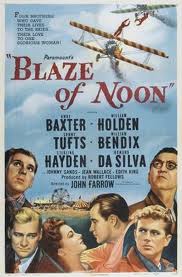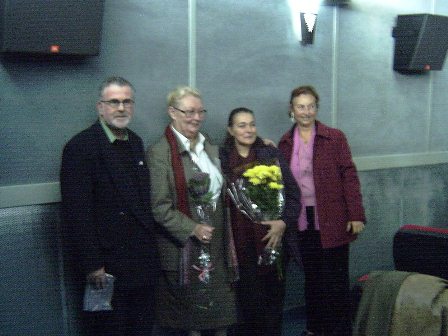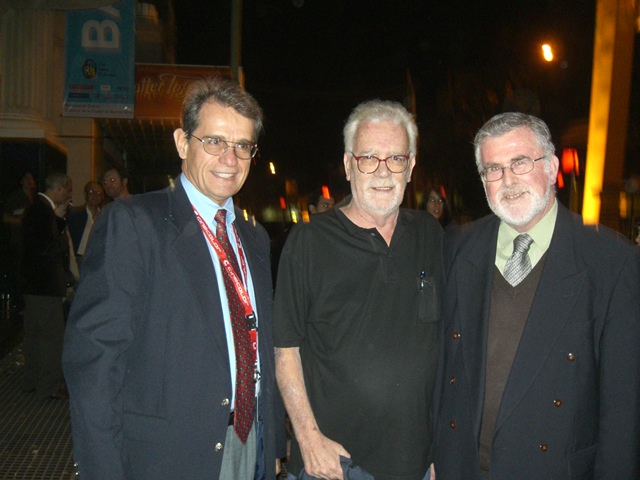Peter MALONE
Breathless

BREATHLESS
France, 1960, 87 minutes, Black and white.
Jean- Paul Belmondo, Jean Seberg, Jean- Pierre Melville.
Directed by Jean- Luc Godard.
Breathless is the directorial debut of New Wave writer-director, Jean - Luc Godard. The screenplay is based on a treatment of three pages by fellow director, Francois Truffaut. A third New Wave director, Claude Chabrol, is billed as Artistic Supervisor.
The film exemplifies the energy and interest in style of the French New Wave of the late '50s. All kinds of devices are used to enhance characters and action. The film relies on the gangster genre and even relies on iris fades, blacked out screen and other old devices. The editing gives the impression of stream of consciousness and the erratic behaviour of the hero. The black and white photography captures the atmosphere of Paris and the French highways.
Jean- Paul Belmondo, soon to emerge as a significant French star, emphasises the homage to Humphrey Bogart. Jean Seberg, after her initial roles in Saint Joan and Bonjour Tristesse, became a favourite actress of continental directors.
The film reflects something of the nihilism of the late '50s - the psychopathic hero, his seeming consciencelessness. This was to remain a feature of so many of the New Wave films in the coming decades. In fact, Jim McBride remade Breathless in the United States in 1983 with Richard Gere as an American version of Belmondo.
1. The impact of the film? Its classic status? Exemplifying the New Wave? The subsequent work of Godard, Truffaut, Chabrol? The blend of the flip and the serious?
2. Black and white photography: Marseilles, Paris and locations, atmosphere and detail? The contemporary world? Streets, shops, theatre, airports, apartments? Newspapers? The style and the transition from a traditional presentation of gangster films to a reliance on technique and devices? Musical score: songs, Mozart?
3. The plausibility and credibility of the plot? The actors -improvising their scenes? Michel as a type? Patricia as a type? The situation: character, encounter, love, test and betrayal? The title?
4. Michel as a contemporary French hero? youthful, energetic? Conscience? Type? Mannerisms? Thumb and lip? Bogart homage? The stealing of the car? On the road and breathless? The gun, the shooting of the policeman? Motivation? The killers? Deaths? Squealers and burglars? Michel propelled forward in his life, Patricia, encounters, contacts? Continuing to steal cars and his techniques? His relationship with Patricia, following her, the night with her, sexual encounter, love? her pregnancy? Wandering the town? Needing money? Papers? The police? Following with the paper? His hiding, taking Patricia with him, her phone call? His staying? His death - and his final comment on her: Bitch? A lively character, purposeless?
5. The contrast with Patricia, work with the Herald Tribune, interviews, the airport, at the office? Her presence in Paris? Friends? The encounter with Michel, fascination with him? Going out, the night? The basis of the relationship? Love or not? Her pregnancy? Sharing with him? The truth? His leaving, her going with him, strained? Her decision to ring the police? To make him go on? The story of the two together, her change of heart? His death? enquiring what his final word meant? The finale with her looking to the camera?
6. The presentation of the police: pursuing Michel, the cinema chase, Michel and the shooting of police?
7. Gangsters, hotels, agencies, car-yards, tip offs? assistant? Contacts? Modelling theatre?
8. The drive of the film and its energy? Interest? An exercise in film-making? and feeling? Audience involvement? Sympathy? Brilliance of surface? Content? meaning?
Blaze of Noon

BLAZE OF NOON
US, 1947, 91 minutes, Black and white.
William Holden, Anne Baxter, Sonny Tufts, Sterling Hayden, William Bendix, Howard da Silva.
Directed by John Farrow.
Blaze of Noon is an aviation drama written by Frank Wead whose life was dramatised with John Wayne in Wings of the Eagle. The film was directed by John Farrow who directed many action films at Paramount during the mid '40s. The film has a good cast, often better than their material. The film pays tribute to the aviation pioneers in airmail flights of 20 years earlier. The film is a blend of romance, good humour and ultimate tragedy. The film reflects America's love for aviation.
1. An entertaining film? The 1920s? American family? The air mall? The pioneer aviators?
2. Black and white photography, aerial sequences? A piece of Americana?
3. The title and the quotation about the early airmail pilots and their bringing the mail through by night, by day and in the blaze of noon? The film as a memoir and tribute?
4. The Mc Donald brothers, their background, abilities as pilots? Their work in the carnival? The visualising of their stunts? The decisions to move on? interest in the airmail services? Their work, skills, accidents?, Their contribution to a developing industry of the '20s.
5. Colin as the central character? His skill as a pilot? moving away from the carnival? His brother's reactions? His friendship with Poppy (and her later turning up)? The discussions with Gafferty? All the brothers joining him? The interview with Lucille and his proposal, marriage? The happiness of the marriage? Work, good fellowship? The visit of Poppy and Lucille wanting him to see her? The birth of the baby? The developments in radio? His staying with flying? The final flight, his radio message of love to Lucille? The pathos of his death? Living on in his son?
6. The other brothers and their friendliness, good fellowship? Roland and his training of his brothers? Making decisions? His skill as a pilot? His moving to car salesmanship? Return to flying? Tad and his skills, the clashes with Lucille and yet his love for her? The reconciliation? His accident? Hospital? The support of Lucille? His work in radio despite his injured leg? Keith and his youthfulness, enthusiasm, the spirit of the family, his crash?
7. Gafferty and the mail, his work with his men, authorities? Hire and fire? Porky? The developments in the industry, radio? Breaking the news to Lucille?
8. Porky as a pilot, his daredevil acts, getting into trouble, friendliness, being sacked, rehired?
9. Poppy as the carnival girl making good on Broadway? Making a pitch for Colin?
10. The predictable elements in the plot? tragedies? Relationships, achievement?
Reykjavik/ Rotterdam

REYKJAVIK-ROTTERDAM
Iceland, 2008, 88 minutes, Colour.
Baltasar Kormakur, Ingvar Eggert Sigurdsson, Lilja Nott Borarinsdottir.
Directed by Oskar Jonasson.
Reykjavik - Rotterdam won a number of awards in Iceland. It is a gritty short drama focusing on smuggling rackets between Holland and Iceland.
Icelandic director Baltasar Kormakur (Reykjavik 101, Jar City, White Wedding) is very good as the smuggler who has spent time in jail, attends AA meetings, has married and has a family, but is trapped into doing one more voyage. His wife’s brother is caught up in a racket and Kristofer, the Kormakur character, is forced into going to Holland, smuggling the alcohol that he was used to doing, but gets caught up in drug trafficking as well. His friend, Steingrimur, exercises pressure on him – and is then betrayed, Steingrimur having moved into drug trafficking as well as having designs on his former girlfriend who is now Kristofer’s wife. The film shows the central character, his friends on the ship helping him with the smuggling, his interactions with the hostile captain, his involvement in a robbery in Rotterdam and his escape back to the boat, his shrewdness in covering all his tracks and surviving to the end.
Actor-director Kormakur was chosen to be the director of the American remake, Contraband with Mark Wahlberg, Kate Beckinsale and Ben Foster. The remake follows the original fairly closely in plot outline while having a bigger budget to elaborate the characters as well as the situations and have quite a number of special effects and action sequences. The new locations were New Orleans to Panama. The ending of the Icelandic film is reproduced quite effectively in Contraband, the villain attacking Kristofer’s wife, wrapping her in plastic and intending her to be buried under cement, only for Kristofer to ring her and her mobile phone indicating where she had been buried.
An interesting film in its own right – and interesting in comparison with the remake.
1. An Icelandic film? Thriller? Grounded in the life of Reykjavik? Smuggling? Family?
2. The Reykjavik settings, the bleakness of the Arctic Circle? The town, homes? The wharves, ships and containers? An authentic feel? The musical score?
3. Kristofer and his history, his working as a security guard, the time spent in prison, his attending AA meetings? His love for Iris, their children? Making ends meet, pressures with rent, the sale of their house? His friendship with Steingrimur? The proposal to do another trip? His conflict with Iris’s brother and his making a mistake? His decision to go, Iris’s reaction, her farewell? The interaction with the captain, Steingrimur ringing him and ensuring Kristofer go on board? To work in the galley and the kitchen? Kristofer meeting his old friends again, setting up the smuggling – alcohol? The arrival in Rotterdam, the experience of the robbery and the contacts, the police, escaping with the van and the Jackson Pollock picture? Being back on the boat on time, the captain finding him in the galley? The van in the container? His covering his tracks? His arrival home, the phone calls, realising that Steingrimur had betrayed him? The interactions with Iris’s brother, the discovery of the drugs? His taking the gang to the captain’s house, ringing the police? His evading them? Confronting Steingrimur on the building site, phoning Iris, hearing the mobile phone ring, rescuing her? In hospital? Painting the house at the end – surviving?
4. Steingrimur, his role in smuggling in the past? His building? His past relationship with Iris? His friendship with Kristofer, the visit, offering him the old fridge, taking away the former fridge? His being a good friend? The irony of his drug dealings? His thugs? Their threatening Iris and the children? His phone calls, to the captain? The final confrontation with Kristofer, his injuring Iris, putting her in the plastic, putting her on the building site? His fear of Kristofer? His arrest?
5. The captain of the ship, hostile to Kristofer because of the past smuggling? Checking on him? The irony of Kristofer sending the thugs to his house? He and his wife being taken in?
6. Iris’s brother, the opening sequence, the thugs pursuing him and his friend? Their throwing the drugs overboard, having to repay? The smuggling of the drugs on the ship? Kristofer discovering this? The end, the thugs confronting Kristofer and the brother in the car, his running away, the pursuit, his falling down the cliff?
7. The reality of the situation, smuggling, the pressure on Kristofer, his techniques? His friends and their participation?
8. Iris, with the children, the threats, the advances of Steingrimur, her being injured, buried, rescued?
9. The grittiness of this film, down-to-earth? The comparisons with the American remake – the work of the actor-director?
Gaston Biraben/ Argentina. Turnhout, April 2005

Ferid Boughedir/ Tunisia. Cannes, 24th May 2008

Eugen Schiller/ Australia. Melbourne, 1st January 2009
 Jan 1 2009.JPG)
Erik Poppe/ Norway. Oslo, 7th November 2009

Enamul Karin Nirjah/ India. Dhaka, 16th January 2010

Elizabeth Bostan/ Romania. Bucharest, November 2005

Eduardo Continho/ Argentina. Buenos Aires, 8th April 2008, centre, with Gustavo Andujar
